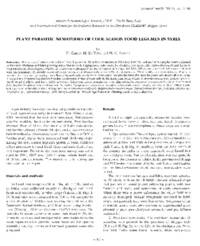Plant parasitic nematodes of cool season food legumes in Syria

Authors:
The survey of plant nematodes of food legumes in Syria was continued in 1984 and 1987-88. Soil and root samples were collected in the major chickpea and lentil growing areas. The most damaging nematodes were the chickpea cyst nematode, Heterodera ciceri and the rootknot nematode, Meloidogyne artiellia. H. ciceri was widespread. In the provinces of Aleppo and Idlib 30% of the surveyed fields were infested with this nematode. M. artiellia occurred in the province of Aleppo only where 13% of chickpea and 5% of lentil crops were infested. Plants in infested fields showed yellowing, poor flowering and early senescence. Root-lesion nematodes were the most frequent nematodes all over Syria. Among them Pratylenchus thornei was the commonest. It was absent only in the north-east Syria, where P. mediterraneus was, instead, present nearly in all chickpea and lentil fields surveyed. Other root-lesion nematodes were Zygotylenchus guevarai, encountered only at Afreen and Pratylenchoides alkani in several areas in the north. Symptoms of root-lesion nematodes infestation were usually not very evident. Other nematodes present, in the rhizosphere of legumes, were Ditylenchus dipsaci, Rotylenchulus macrosomus, Tylenchorhynchus sp., Helichotylenchus sp., Trophurus sp., Aphelenchoides sp., and Paratylenchus sp., whose significance in affecting yields is still unknown.
